Top News

March 14, 2017 Ryukyu Shimpo
A talk and live event was held by musician and producer Tetsuya Komuro, Computer Graphics artist and professor of the University of Tokyo Graduate School, Yoichiro Kawaguchi, electronic music producer Hideki Matsutake and Okinawa traditional performing artists on February 18 at Music Town Oto Ichiba in Okinawa City. The Okinawa Prefectural Government presented this event as part of an arts manager training project.
The performers tried a new fusion of Ryukyu traditional dance, sanshin song, electronic music and CG, in a live stage show.
The CG artist captured the elegant movements of Ryukyu traditional dance artists Sayuri Chibana and Yoshikazu Sanabe using sensors, and generated CG images in real time on the background.
In the talk, they also discussed exploring possibilities and issues in the arts in Okinawa.
Professor Kawaguchi said, “Science helps create a new art. I hope that a laboratory to study the art of the future will be established in Okinawa.”
Komuro said, “In Okinawa, there are lots of good materials and facilities with which people can learn about producing and management. I guess it is a space matter. There is a possibility that these activities will end up taking place in a small community.”
(English translation by T&CT)
Go to Japanese
March 9, 2017 Ryukyu Shimpo
Civic group representatives submit signatures to opposition party Diet members on March 9 at the House of Representatives 1st Diet Members’ Building.
As of March 9, an appeal titled “Nationwide United Signatures Calling for Respect for the Okinawan People’s Will and Retraction of Forcing Bases on Okinawa” had gathered 1,212,281 signatures. The appeal opposes the construction of a new base in Henoko, Nago City, Okinawa in conjunction with the relocation of U.S. Marine Corps Air Station Futenma and the construction of helipads in conjunction with the return of roughly half of the U.S. military’s Northern Training Area (in Kunigami Village and Higashi Village, Okinawa). This appeal has collected more signatures than any other appeal of its kind opposing base construction in Okinawa. The civic groups that collected the signatures held a gathering on March 9 at the House of Representatives 1st Diet Members’ Building, where they submitted the signatures to opposition party Diet members and called on them to file a petition for immediate cessation of the new base construction.
The signatures were collected from all around Japan since October of last year by cooperation between three civic groups: “Okinawa Council Opposing Base Relocation Within Okinawa”, “’Stop! Henoko Land Reclamation’ Diet Building Encirclement Action Committee”, and “Don’t Allow War/Don’t Destroy Article 9! United Action Committee”. Roughly 20 Diet members attended the gathering on March 9 to accept the signatures, including representatives from the Democratic Party, the Japan Communist Party, the Social Democratic Party, and the Liberal Party, as well as from the House of Councilors faction “Okinawa Whirlwind”.
The three groups will continue to collect signatures until April 25, and hope to broaden support nationwide. Okinawa Peace Movement Center director Satoru Oshiro, who attended the gathering, expressed gratitude for efforts being made nationwide and said, “We cannot accept the suppression, which could be called discrimination, currently occurring against Okinawa, and we will not surrender to it. We will without a doubt stop the ongoing base construction for the sake of our children’s futures. My determination is stronger than ever.”
(English translation by T&CT and Sandi Aritza)
Go to Japanese
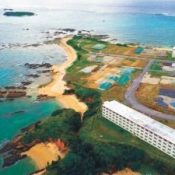
March 8, 2017 Ryukyu Shimpo
By Kazuki Furugen
On March 7, the Nago City Board of Education (BOE) requested the Okinawa Defense Bureau (ODB) to conduct a cultural property survey for the sea area of Ora Bay. This must be done before reclaiming the area from the sea. The U.S. military Futenma Air Base is to be relocated to this area located in Henoko, Nago. Last July, part of U.S. military Camp Schwab, which has plans to be remodeled, was recognized as a new historical site, the “Nagasaki Kaneku Relic Scattered Area.” This area includes both land and sea. According to the Cultural Properties Protection Law, the relic scattered area including the sea area must be surveyed before being remodeled. The Nago BOE has also requested for the sea area outside of the relic scattered area to be surveyed because there is a high likelihood of it containing related cultural properties. Depending on how the survey goes, it may affect the construction schedule.
The ODB responded to Ryukyu Shimpo’s questions as follows: “Regarding the cultural property survey within Camp Schwab, both Okinawa prefecture and the Nago BOE have coordinated. (We) will continue to follow related laws and regulations, and respond appropriately.”
During the 2015 cultural property survey, the Nago BOE discovered clayware, stoneware, ceramic ware, and anchor stones at the land and sea. This led to the area being recognized as a new historical site in July of 2016 by the Okinawa BOE. Up until now, the Nago BOE has hardly any history of conducting cultural property surveys for the sea. However, they acknowledge the need for a sea area survey to be conducted. Additionally, while receiving counsel from the Cultural Properties Division of the Okinawa Education Bureau, they are in a hurry to put together plans for the technological aspects of the survey, duration, and area to be covered. Culture Division of the Nago BOE clarified their standpoint by saying that it is possible that some of the cultural properties may have been carried from the land into the sea. They also explained that they are coordinating with the ODB.
Okinawa Archeological Association Chairman Shiichi Touma pointed out, “Even if it is underwater, it would be considered a buried cultural property. Anchor stones have also been found, which means that people had made a living from the sea.” Regarding the scope of the cultural property for the sea area, he said, “We won’t know how (it) will expand until the survey is conducted.” He therefore emphasized the need to survey the sea far and wide.
(English translation by T&CT and Chelsea Ashimine)
Go to Japanese
March 9 2017 Ryukyu Shimpo
In a helipad commonly called a “Falcon”, located at Camp Hansen in the vicinity of the Shirohara district of Ginoza Village on March 8, the U.S.Marines Corps in Okinawa resumed for the first time in about three months chopper flight training that involves suspending objects. The aircraft accidently dropped several vehicle tires from the sky into the base. Local resident Tadanobu Izumi, who witnessed the training, said, “We have requested the U.S. military not to fly around the village because an MV-22 Osprey vertical takeoff and landing aircraft belonging to the Futenma base in Ginowan crashed into shallow water off the coast of Abu in Nago City last December. We, the local residents, feel fear about the military flight training.”
In response to protest from the local citizens, the military had suspended training since December 9, 2016. According to the residents, the two military aircraft took off from the Falcon helipad around 2:30 p.m. on March 8. They carried out the flight training while suspending objects in the military area.
According to the Marine Corps, objects fell from the UH-1 helicopter. The cause of the accident is under investigation.
As of 9:30 p.m. on March 8, there was no confirmation regarding any damage to the local area. The U.S. military explained that they carried out the training for humanitarian assistance or disaster relief.
It is reported that the chopper hovered in the air area provided to the U.S. military in the Nakagawa district of Kin Town adjacent to Shirohara district for about 40 minutes from about 2:52 p.m. after the flight training. On the same day after the accident, staff of the Okinawa Defense Bureau rushed into the accident site and monitored whether or not the military had resumed training.
(English translation by T&CT)
Go to Japanese
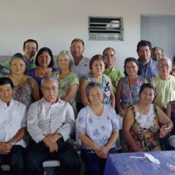
March 6, 2017 Celso Akihde Shiroma, Correspondent of Ryukyu Shimpo
On February 12, at the house of Tetsunori Futenma in Kotia near Sao Paulo, Brazil, people related to Oshiro of the former Ozato Village (now Nanjo City) gathered for the first time in half a century. The gathering was the result of a call-out to immigrants and their descendants as part of work to compile an ethnohistory book of Ozato. Participants agreed to keep in touch with each other and cooperate.
Twenty-seven people participated. The Futenma Family, Arakaki Family, Oshiro Family, and Shiroma Family gathered and ate lunch together. Each family brought one dish of food. They enjoyed the food while deepening their friendships, and discussing each other’s family history.
They also prepared a birthday cake for Masaaki Shiroma, born in the year of the Rooster as a celebration of his birth year.
(English translation by T&CT and Megumi Chibana)
Go to Japanese

March 11, 2017 Ryukyu Shimpo
On March 10, the Okinawa Defense Bureau (ODB) began work to set up silt protectors in the temporarily restricted area on Oura Bay, Henoko, Nago, to mitigate the impact of construction of a new airfield, which is part of a replacement facility for the U.S. Futenma base in Ginowan. This work will be carried out prior to the commencement of bank protection work. (Silt protector is a flexible membrane product that has been designed to physically prevent diffusion of pollution generated in dredging or reclamation works on the seas or rivers.)
The construction has entered a new phase. The ODB plans to set up the silt protectors at four locations by the end of April. The work including dredging towards the landfill will begin after the completion of bank protection work, which may start in May.
Citizens aboard four ships and 11 canoes protested against the base construction, holding placards reading: “Don’t kill the sea,” “Stop landfill.”
On March 10, a small ODB working ship towed about 460 meters of pollution prevention membranes to various points off Henokozaki.
The membranes were likely tied up to large concrete blocks at the bottom of the sea.
The submerging of blocks, which started in February, continues. It is estimated that more than 60 percent of the planned 228 concrete blocks might have been submerged.
At 8:45 a.m. in front of the Camp Schwab gate, about 50 riot police officers forcibly removed about 20 sit-in-protesters, and 44 construction-related vehicles, including dump trucks, entered the base.
(English translation by T&CT)
Go to Japanese
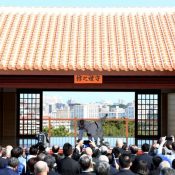
March 5, 2017 Ryukyu Shimpo
Hailed as the home of karate in Okinawa, the birthplace of karate, The Okinawa Karate Kaikan opened March 4 at the Tomigusuku Castle Ruins Park in Tomigusuku. Around 700 people including members of the karate community from both Japan and abroad, and people from economic organizations and recreation associations in Okinawa joined in the inauguration, gathering around the new stage of Okinawa karate. There are over 100 million karate lovers worldwide, and the new facility is expected to attract visitors as a symbol of Okinawa Karate, and drive karate’s listing as a UNESCO intangible cultural heritage element.
Starting with a commemorative tree planting by the karate community, the inauguration commenced with events such as a performance by the keepers of Okinawa’s intangible cultural assets, Okinawa Karate and Kobudo, a tape cutting, the ceremonial pouring of awamori into a kame pot, and an opening ceremony.
Governor Takeshi Onaga greeted participants, saying, “The Okinawa Karate Kaikan is a tangible symbol to share Okinawa with the world as the birthplace of karate. A place where karate practitioners of the world can gather, and from increased interaction inherit the spirituality of karate from the Okinawans who preceded them. I would like for the karate hall to be the central hub for studying the essence of Okinawa Karate, and for it to contribute to the development of karate worldwide.”
Guest speaker Choko Kiyuna, chairman of the Okinawa Traditional Karate Promotion Association added with conviction, “Karate, representative of Okinawan culture, has been selected as an event at the 2020 Tokyo Olympics, drawing worldwide attention to Okinawa. With the Okinawa Karate Kaiakan, a place Okinawans can boast of, as the central location, I would like to work towards spreading karate, and enthusiasm for karate, throughout the world.”
The Okinawa Karate Kaikan opened to the general public March 5, and there is a free shuttle bus departing from the Okinawa prefectural office.
(Translation by T&CT and Sam Grieb)
Go to Japanese
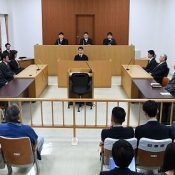
March 7, 2017 Ryukyu Shimpo
On the morning of March 7 the Naha District Court handed down a decision in the case concerning the Okinawa prefectural government (OPG) decision to disclose an agreement between the governments of Okinawa, Japan, and the U.S. on the use of prefectural road 70, a joint-use road that stretches through Takae, Higashi Village. Under presiding judge Kenichi Mori the court declared that it was illegal for the OPG to disclose the agreement documents without consent from the U.S. and Japanese governments. As such, the court ordered the OPG to cancel its decision to disclose as the Japanese government demands.
This case was brought before the court in March 2015. Although prefectural road 70 lies on land provided for U.S. military use, based on the U.S.-Japan Status of Forces Agreement both governments decided in 1990 to jointly use the road. Local residents opposing the construction of helipads in the Northern Training Area continue to use the shoulder of this road to engage in activities to block construction.
As a method of removing these residents the Okinawa Defense Bureau has been looking to change the road to a zone for exclusive use by the U.S. military. In response, a man opposing helipad construction appealed for the disclosure of documents from the agreement pertaining to prefectural road 70 under an information disclosure ordinance.
(English translation by T&CT and Erin Jones)
Go to Japanese
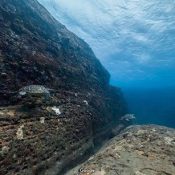
March 2, 2017 Ryukyu Shimpo
The online search engine, Google, added eight underwater sites around Okinawa to the company’s map application, Underwater Street View. The application provides underwater panoramic views and lets its users enjoy “taking a walk” around sites including the best diving spots in Japan, Kerama Islands. Google started providing under water streetview in 2012 with photos featuring globally famous ocean destinations such as Australia, the Philippines, and Hawaii, however this is the first time the company has shown photos of the water around Japan.
The photographs were taken with support from the Okinawa Convention and Visitors Bureau (OCVB). Staff say they hope it will be a boost for tourism; “we would like to promote the beauty of Okinawa to home and abroad.”
There are eight new viewable areas including the biggest coral reef in Japan, Sekisei shoko coral reef, which covers the area between Ishigaki and the Miyako Islands, as well as the Yonaguni under water landscape, Kitahama in Aka Island, Nagura bay-giant potato in Ishigaki Island, Yamada point in Onna village, Taketomi Island, Zamami Island, and Aharen beach in Tokashiki Island.
Underwater photographer, Christophe Bailhache, shot Yamada point in Onna village in November 20, 2016. His photos will be among the new images in Google underwater streetview. A representative of Google said, “Many people cannot go underwater very easily. We would like to make dreams come true for those who would love to see beautiful coral reefs and fish using the Street view.”
Street view is one of the Google Map services that Google provides. Users can see panoramic photos of towns and tourism destinations using computers and smartphones, and the service is used to prepare for trips and provide details about places.
The OCVB will aim to continue the collaboration with Google with support from local divers. They plan to expand the coverage to northern Okinawa Island and neighboring islands. A representative of the OCVB said they expected the map application to attract much interest; “We hope this will intrigue not only those who enjoy snorkeling and diving but also those who research coral reefs.”
(English translation by T&CT and Sayaka Sakuma)
Go to Japanese
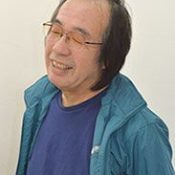
March 8, 2017 Ryukyu Shimpo
On March 8, 66-year-old Hiroshi Inaba, who has been active in the protest against construction of the new base in Henoko, Nago, which is part of the relocation of the U.S. Futenma airfield in Ginowan, was released after being detained in the Naha Detention Center for more than three months. He was arrested and prosecuted on the charge of forcible obstruction of business.
The Naha District Court decided to release him on bail on March 7.
After he was freed, Inaba said, “I couldn’t endure anymore really. I am relieved now.” He also told supporters who gathered in front of the detention center demanding his release, “Your voices reached me every day including Saturday and Sunday and encouraged me. I am grateful to you from the bottom of my heart.”
He was concerned about Hiroji Yamashiro, director of the Okinawa Peace Movement Center, who remains in detention, saying, “He is not allowed to have any visitors beside his lawyers. He is in a tougher situation than me. My heart hurts thinking about him.”
(English translation by T&CT)
Go to Japanese
February 26, 2017 Ryukyu Shimpo
Donations to Okinawa Prefecture’s “Chura Yuimaru Donation,” part of the Furusato Tax Program, which allows residents to divert part of their residence and income tax to a local government of their choice, are increasing. In the fiscal year 2016, as of the end of December last year, the tax payment amounted to 79,344,980 yen, which was about 1.75 times the 2015 total (about 34.08-million-yen increase), and a new record. According to the Prefectural Tax Department, donations have increased since Governor Takeshi Onaga, who opposes the construction of the new Henoko base, was inaugurated. There was also a significant donation of over one million yen in the fiscal year of 2016.
Competitions of returning goods occur nationwide to collect donations of the Furusato Tax. The Ministry of Internal Affairs and Communications is considering corrective measures. Okinawa Prefecture stopped giving away locally produced goods in return since January 2016. Despite that, donations are still increasing. The Tax Division noted rising awareness of the program and stated that pure donations without an aim for return is much appreciated.
As of the end of December 2016, the number of donations decreased by 313 from the fiscal year of 2015 to 541 cases. Among them, individual donations dropped by 314 cases, to 537 cases. However, the amount increased by 1.72 times (about 3,232 million yen increase) to 77,232,177 yen. The number of companies rose to 4, about 5.93 times (about 1.76 million yen increase), 2,112,803 yen.
There were five significant donations in the fiscal year of 2015, but nine by the end of December 2016. Details of donors are not disclosed, however, 97% donate from outside of the prefecture, and some donate twice or more. Donors who agree with Governor Onaga’s political stance enclose messages such as “Please protect the sea,” “For peace activities,” “Use it to improve child poverty.”
The Furusato tax payment gets incorporated into general revenue that the prefecture can use freely. As of the end of December 2016 it was expected to exceed 56,279,000 yen, which is the amount of budget assigned to the Henoko New Base Construction problem countermeasure project planned for the fiscal year of 2017.
(English translation by T&CT and Megumi Chibana)
Go to Japanese








 Webcam(Kokusai Street)
Webcam(Kokusai Street)


